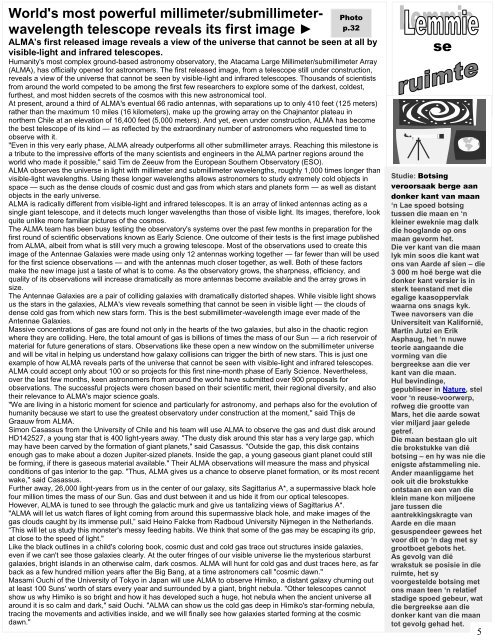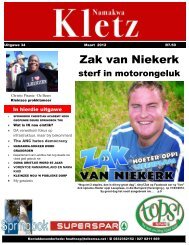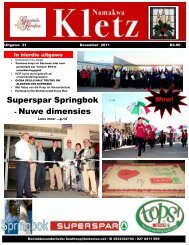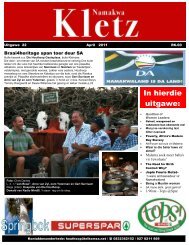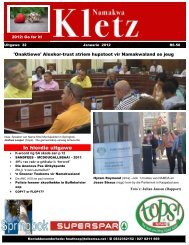Geestelike voedsel
Geestelike voedsel
Geestelike voedsel
Create successful ePaper yourself
Turn your PDF publications into a flip-book with our unique Google optimized e-Paper software.
World's most powerful millimeter/submillimeterwavelength<br />
telescope reveals its first image ►<br />
Photo<br />
p.32<br />
ALMA‟s first released image reveals a view of the universe that cannot be seen at all by<br />
visible-light and infrared telescopes.<br />
Humanity's most complex ground-based astronomy observatory, the Atacama Large Millimeter/submillimeter Array<br />
(ALMA), has officially opened for astronomers. The first released image, from a telescope still under construction,<br />
reveals a view of the universe that cannot be seen by visible-light and infrared telescopes. Thousands of scientists<br />
from around the world competed to be among the first few researchers to explore some of the darkest, coldest,<br />
furthest, and most hidden secrets of the cosmos with this new astronomical tool.<br />
At present, around a third of ALMA's eventual 66 radio antennas, with separations up to only 410 feet (125 meters)<br />
rather than the maximum 10 miles (16 kilometers), make up the growing array on the Chajnantor plateau in<br />
northern Chile at an elevation of 16,400 feet (5,000 meters). And yet, even under construction, ALMA has become<br />
the best telescope of its kind — as reflected by the extraordinary number of astronomers who requested time to<br />
observe with it.<br />
"Even in this very early phase, ALMA already outperforms all other submillimeter arrays. Reaching this milestone is<br />
a tribute to the impressive efforts of the many scientists and engineers in the ALMA partner regions around the<br />
world who made it possible," said Tim de Zeeuw from the European Southern Observatory (ESO).<br />
ALMA observes the universe in light with millimeter and submillimeter wavelengths, roughly 1,000 times longer than<br />
visible-light wavelengths. Using these longer wavelengths allows astronomers to study extremely cold objects in<br />
space — such as the dense clouds of cosmic dust and gas from which stars and planets form — as well as distant<br />
objects in the early universe.<br />
ALMA is radically different from visible-light and infrared telescopes. It is an array of linked antennas acting as a<br />
single giant telescope, and it detects much longer wavelengths than those of visible light. Its images, therefore, look<br />
quite unlike more familiar pictures of the cosmos.<br />
The ALMA team has been busy testing the observatory's systems over the past few months in preparation for the<br />
first round of scientific observations known as Early Science. One outcome of their tests is the first image published<br />
from ALMA, albeit from what is still very much a growing telescope. Most of the observations used to create this<br />
image of the Antennae Galaxies were made using only 12 antennas working together — far fewer than will be used<br />
for the first science observations — and with the antennas much closer together, as well. Both of these factors<br />
make the new image just a taste of what is to come. As the observatory grows, the sharpness, efficiency, and<br />
quality of its observations will increase dramatically as more antennas become available and the array grows in<br />
size.<br />
The Antennae Galaxies are a pair of colliding galaxies with dramatically distorted shapes. While visible light shows<br />
us the stars in the galaxies, ALMA's view reveals something that cannot be seen in visible light — the clouds of<br />
dense cold gas from which new stars form. This is the best submillimeter-wavelength image ever made of the<br />
Antennae Galaxies.<br />
Massive concentrations of gas are found not only in the hearts of the two galaxies, but also in the chaotic region<br />
where they are colliding. Here, the total amount of gas is billions of times the mass of our Sun — a rich reservoir of<br />
material for future generations of stars. Observations like these open a new window on the submillimeter universe<br />
and will be vital in helping us understand how galaxy collisions can trigger the birth of new stars. This is just one<br />
example of how ALMA reveals parts of the universe that cannot be seen with visible-light and infrared telescopes.<br />
ALMA could accept only about 100 or so projects for this first nine-month phase of Early Science. Nevertheless,<br />
over the last few months, keen astronomers from around the world have submitted over 900 proposals for<br />
observations. The successful projects were chosen based on their scientific merit, their regional diversity, and also<br />
their relevance to ALMA's major science goals.<br />
"We are living in a historic moment for science and particularly for astronomy, and perhaps also for the evolution of<br />
humanity because we start to use the greatest observatory under construction at the moment," said Thijs de<br />
Graauw from ALMA.<br />
Simon Casassus from the University of Chile and his team will use ALMA to observe the gas and dust disk around<br />
HD142527, a young star that is 400 light-years away. "The dusty disk around this star has a very large gap, which<br />
may have been carved by the formation of giant planets," said Casassus. "Outside the gap, this disk contains<br />
enough gas to make about a dozen Jupiter-sized planets. Inside the gap, a young gaseous giant planet could still<br />
be forming, if there is gaseous material available." Their ALMA observations will measure the mass and physical<br />
conditions of gas interior to the gap. "Thus, ALMA gives us a chance to observe planet formation, or its most recent<br />
wake," said Casassus.<br />
Further away, 26,000 light-years from us in the center of our galaxy, sits Sagittarius A*, a supermassive black hole<br />
four million times the mass of our Sun. Gas and dust between it and us hide it from our optical telescopes.<br />
However, ALMA is tuned to see through the galactic murk and give us tantalizing views of Sagittarius A*.<br />
"ALMA will let us watch flares of light coming from around this supermassive black hole, and make images of the<br />
gas clouds caught by its immense pull,‖ said Heino Falcke from Radboud University Nijmegen in the Netherlands.<br />
―This will let us study this monster's messy feeding habits. We think that some of the gas may be escaping its grip,<br />
at close to the speed of light."<br />
Like the black outlines in a child's coloring book, cosmic dust and cold gas trace out structures inside galaxies,<br />
even if we can't see those galaxies clearly. At the outer fringes of our visible universe lie the mysterious starburst<br />
galaxies, bright islands in an otherwise calm, dark cosmos. ALMA will hunt for cold gas and dust traces here, as far<br />
back as a few hundred million years after the Big Bang, at a time astronomers call "cosmic dawn."<br />
Masami Ouchi of the University of Tokyo in Japan will use ALMA to observe Himiko, a distant galaxy churning out<br />
at least 100 Suns' worth of stars every year and surrounded by a giant, bright nebula. "Other telescopes cannot<br />
show us why Himiko is so bright and how it has developed such a huge, hot nebula when the ancient universe all<br />
around it is so calm and dark," said Ouchi. "ALMA can show us the cold gas deep in Himiko's star-forming nebula,<br />
tracing the movements and activities inside, and we will finally see how galaxies started forming at the cosmic<br />
dawn."<br />
5<br />
se<br />
Studie: Botsing<br />
veroorsaak berge aan<br />
donker kant van maan<br />
„n Lae spoed botsing<br />
tussen die maan en „n<br />
kleiner eweknie mag dalk<br />
die hooglande op ons<br />
maan gevorm het.<br />
Die ver kant van die maan<br />
lyk min soos die kant wat<br />
ons van Aarde af sien – die<br />
3 000 m hoë berge wat die<br />
donker kant versier is in<br />
sterk teenstand met die<br />
egalige kaasoppervlak<br />
waarna ons snags kyk.<br />
Twee navorsers van die<br />
Universiteit van Kalifornië,<br />
Martin Jutzi en Erik<br />
Asphaug, het „n nuwe<br />
teorie aangaande die<br />
vorming van die<br />
bergreekse aan die ver<br />
kant van die maan.<br />
Hul bevindinge,<br />
gepubliseer in Nature, stel<br />
voor „n reuse-voorwerp,<br />
rofweg die grootte van<br />
Mars, het die aarde sowat<br />
vier miljard jaar gelede<br />
getref.<br />
Die maan bestaan glo uit<br />
die brokstukke van dié<br />
botsing – en hy was nie die<br />
enigste afstammeling nie.<br />
Ander maanliggame het<br />
ook uit die brokstukke<br />
ontstaan en een van die<br />
klein mane kon miljoene<br />
jare tussen die<br />
aantrekkingskragte van<br />
Aarde en die maan<br />
gesuspendeer gewees het<br />
voor dit op „n dag met sy<br />
grootboet gebots het.<br />
As gevolg van dié<br />
wrakstuk se posisie in die<br />
ruimte, het sy<br />
voorgestelde botsing met<br />
ons maan teen „n relatief<br />
5<br />
stadige spoed gebeur, wat<br />
die bergreekse aan die<br />
donker kant van die maan<br />
tot gevolg gehad het.<br />
5


